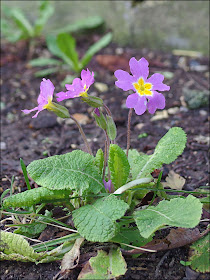Just south of the small town of Royston the land suddenly rises up like a great grass-covered wave stretching east and west as far as the eye can see. As you come from the flat farmland of Cambridgeshire its height is accentuated by its sheer unexpectedness. Anyone who takes the trouble to ascend the 50 metres or so to the top of the rise finds themselves in some strangely un-English scenery.
The fields stretch away in a succession of gentle swells broken by occasional scanty hedges which do little to impede the wind. There are few trees and the plough has scored through the thin, chalky soil to give the terrain a cold and frosted appearance.
I got off the train at Ashwell and Morden station and crossed the busy A505 road and commenced the trudge up Gallows Hill where, standing on a Bronze-Age burial mound was a clump of suitably dark, skeletal trees.
The footpath network here is sparse and doesn't obligingly connect up unless the walker resorts to a little road walking. But the roads are straight and it's so quiet that approaching cars can easily be heard above the singing skylarks and the occasional mewing buzzard.
The views are so far-reaching that there's a real "top of the world" feeling here, even though the elevation is modest indeed.
And yet every so often land, light and atmosphere conspire to create subtle flowing scenes. Where does that look like? Mongolia? Patagonia? Certainly not Spring in Hertfordshire!
A little further along and yellow catkins against a blue sky remind me that I'm just a few miles from home.
By now the overnight frost had departed from the top inch or so of the muddy fieldpaths making them greasy and unpleasant walking. At intervals along the edge of the field there were large flints, moved aside from the line of harrow or seed drill. These flint nodules appear in layers within the chalk and are composed of a hard, black, glassy form of silica. The exact process of their formation puzzled geologists for decades and, if anyone's interested, a clear and concise explanation can be found here.
Stone-Age man, of course, had taken an interest in flint from the dawn of history because it was found to be perfect for making cutting tools, as when it was split open it produced sharp-edged shards, which could be further perfected by a skilled "flint-knapper".
Our path then enters Fox Covert where woodland survives despite the thin covering of soil. The path soon erodes down to the bare bones of the root system.
And in the wood my eye was attracted to a sawn-through log. Chainsaw-marks, tree-rings, the cracks of age and a pioneering strand of ivy combine to make a pleasing picture, in much the same way that geology, history and the hand of man have interacted to form the scenery.
Take care.






















































